Science & Data Document Library
Science and Data Resources
Investigation of Volatile Organic Compounds in Groundwater Uvalde, Texas Edwards Underground Water District Field Activities from January 1984 through April 1988

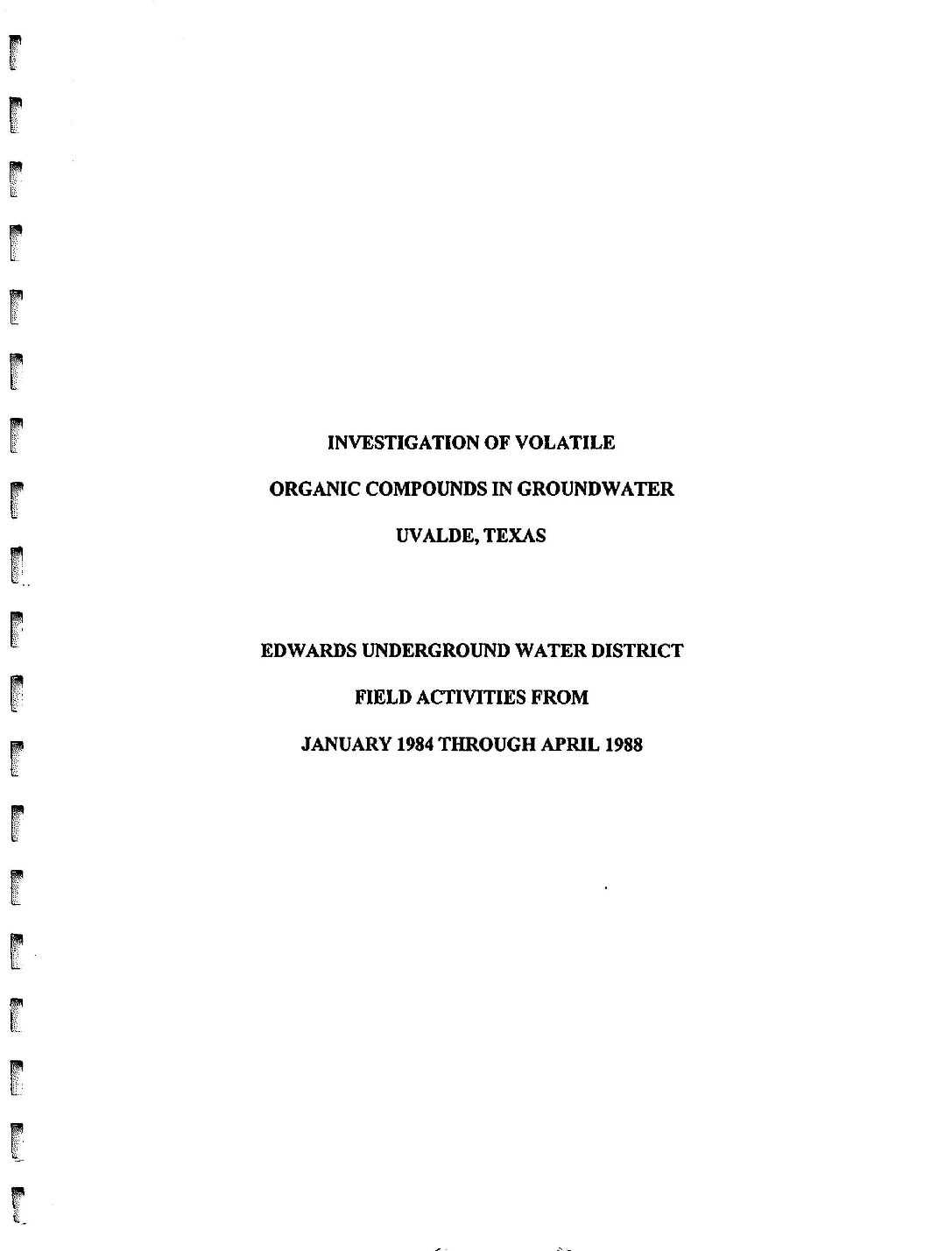
Description: Survey of groundwater to determine the source of tetrachloroethylene (PCE) in the Edwards Aquifer near the Uvalde, TX airport
Location: Edwards Aquifer - Uvalde Area
Summary:The Edwards Underground Water District (EUWD) has been involved in an investigation to determine the source of volatile organic compounds (VOCS) in the Edwards aquifer in the Uvalde, Texas area (fig. 1). Existing Edwards aquifer wells were used to trace voc contamination up the hydraulic gradient in a west-northwest direction from the point of initial discovery to an area where highly contaminated wells exist. Wells further up the hydraulic gradient and in a distinct area around the contaminated area are free of VOC contamination. A monitor well drilling and sampling program was employed to better define the source area. Surface and subsurface geophysical techniques were used to reinforce monitor well data and further delineate a source area.
From September 1983 through February 1984 the u.s. Geological Survey (USGS) collected water samples from selected wells to provide baseline data on volatile organic compounds (VOC) in the Uvalde area. The samples were collected under a cooperative contract with the EUWD. Most samples were collected from public supply wells, however, some samples were collected from private wells. In February 1984 five wells were sampled for VOCs in the Uvalde area (see Appendix B for details of all sampling events).
The only VOC found was tetrachloroethylene (PCE) at a level of 6.4 micrograms per liter (ug/l) in a municipal well located at the Uvalde County airport (Garner Field). This VOC contaminated groundwater sample prompted further investigation.
To verify contamination in the vicinity of the municipal airport two sampling events were conducted in April and August, 1984. A total of eight wells were sampled including the airport well. Of the eight wells four showed PCE contamination.
Four wells drawing water from the Edwards aquifer were polluted with the same compound. This was sufficient evidence to rule out contamination by well construction materials or laboratory error. At this point it was reasonable to assume the volatile organic compound tetrachloroethylene (PCE) existed in the Edwards aquifer in the vicinity of the municipal airport.
Water Quality at Selected Locations in the San Antonio Area, Texas: Progress Report, 1972

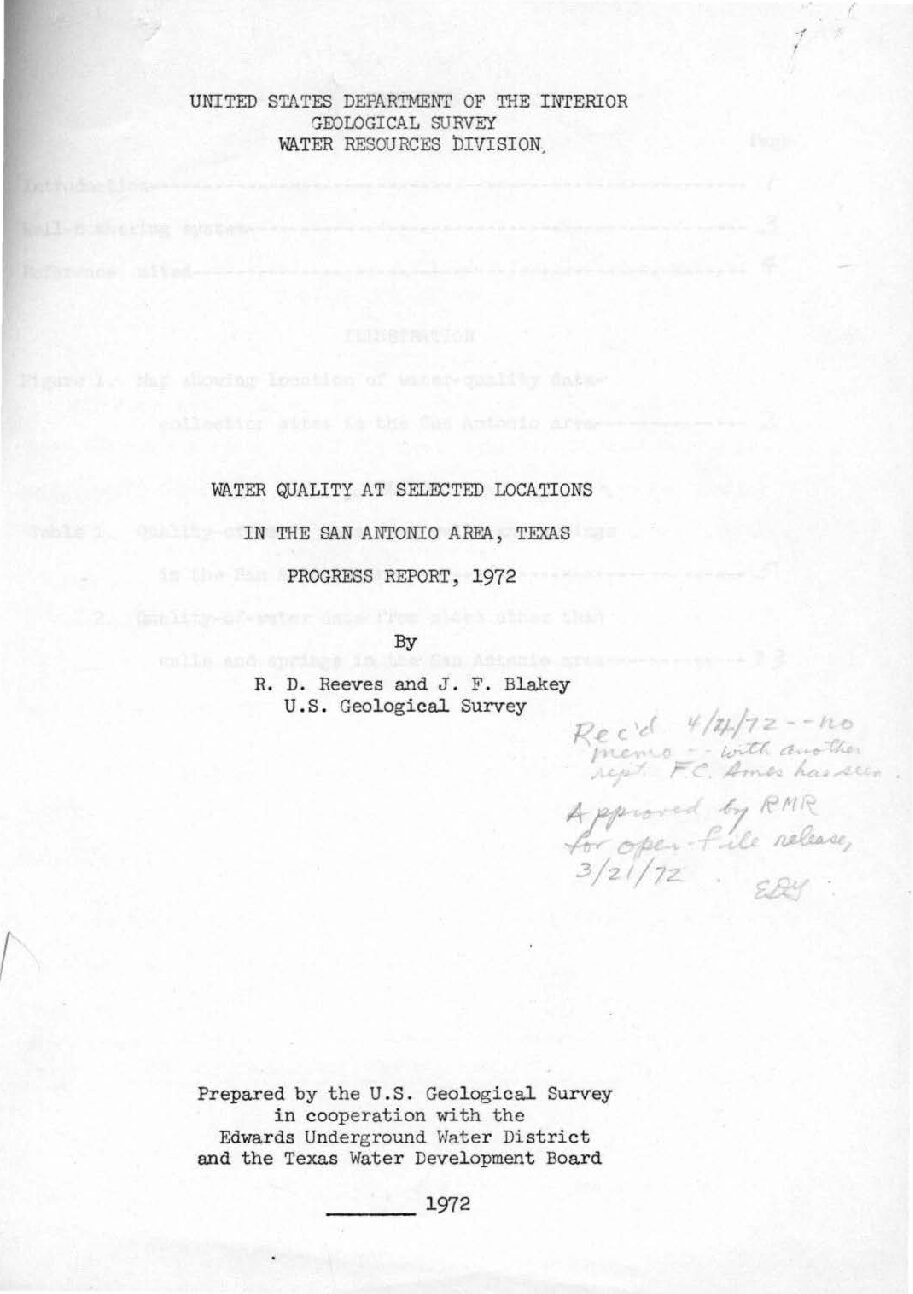
Description: Results of water quality testing at selected sites in the Edwards Aquifer from September 1969 August 1971
Location: Edwards Aquifer Balcones Fault Zone San Antonio Segment
Summary:The U.S. Geological Survey, in cooperation with the Edwards Underground Water District and the Texas Water Development Board, is conducting a continuing investigation of water quality in the aquifer formed by the Edwards and associated limestones in the San Antonio area.
The program was initiated in 1968 to collect historical reference data for determining changes in water quality and to detect any current pollution of the ground water. Results of the study from August 1968 to August 1969 are reported by Reeves and Blakey (1970) .
This report includes water-quality data collected from September 1969 to August 1971 and some data from selected analyses made prior to 1969.
Chemical and Bacteriological Quality of Water at Selected Sites in the San Antonio Area, Texas February 1975-September 1977

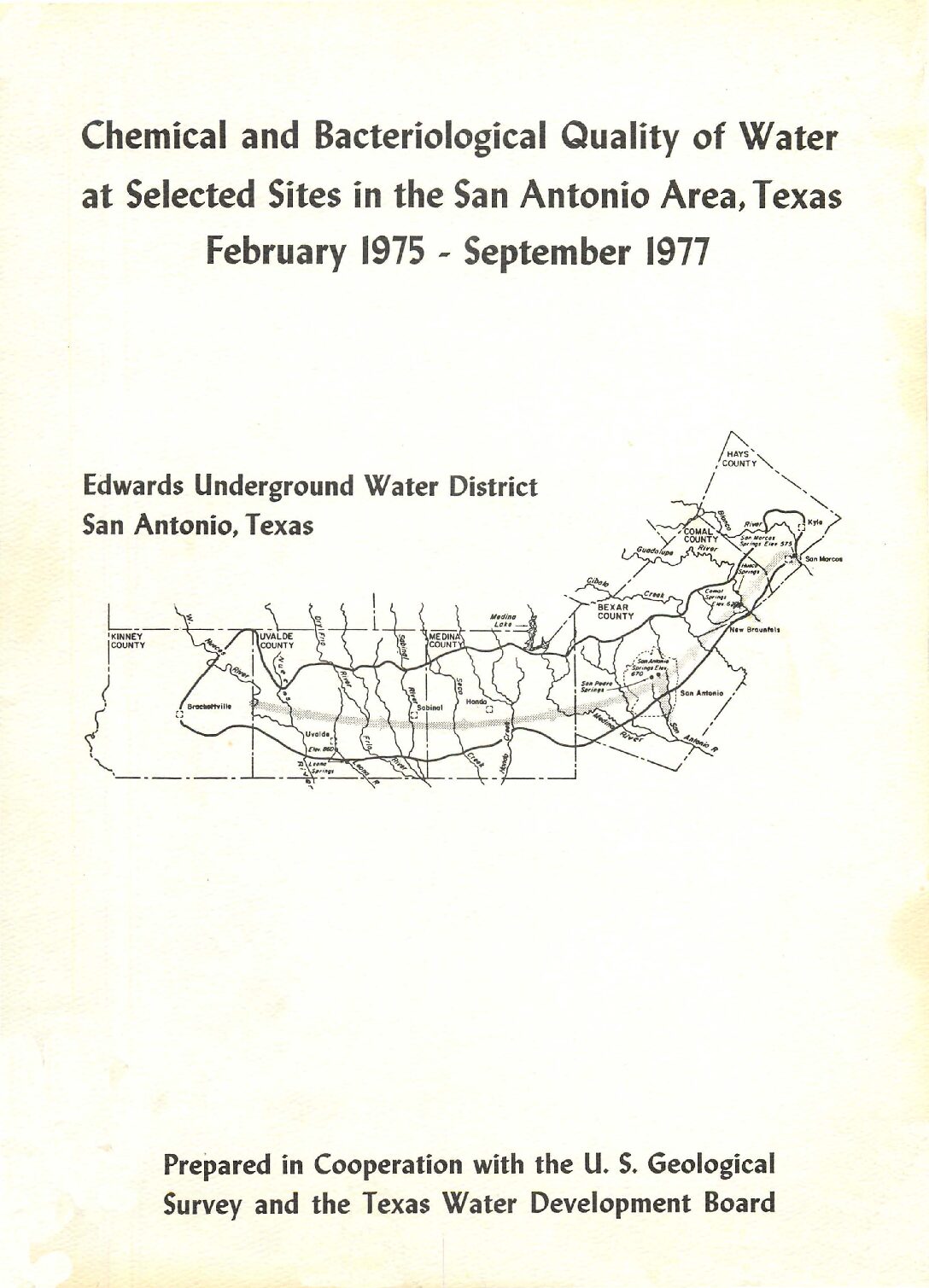
Description: Surface and groundwater quality monitoring in the San Antonio area, 1975-1977. Note: Page-size and full-size plate are at the end of the document.
Location: Edwards Aquifer, Balcones Fault Zone, San Antonio Segment, and associated surface water
Summary:Water samples collected from 79 wells and 3 springs in the Edwards aquifer were analyzed for more than 50 properties or constituents, most of which affect the suitability of the water for domestic use. The samples were analyzed for bacteria; major inorganic constituents; minor elements, including heavy metals; and pesticides.
Water quality of the Edwards Aquifer and streams recharging the aquifer in the San Antonio region, Texas (Map)

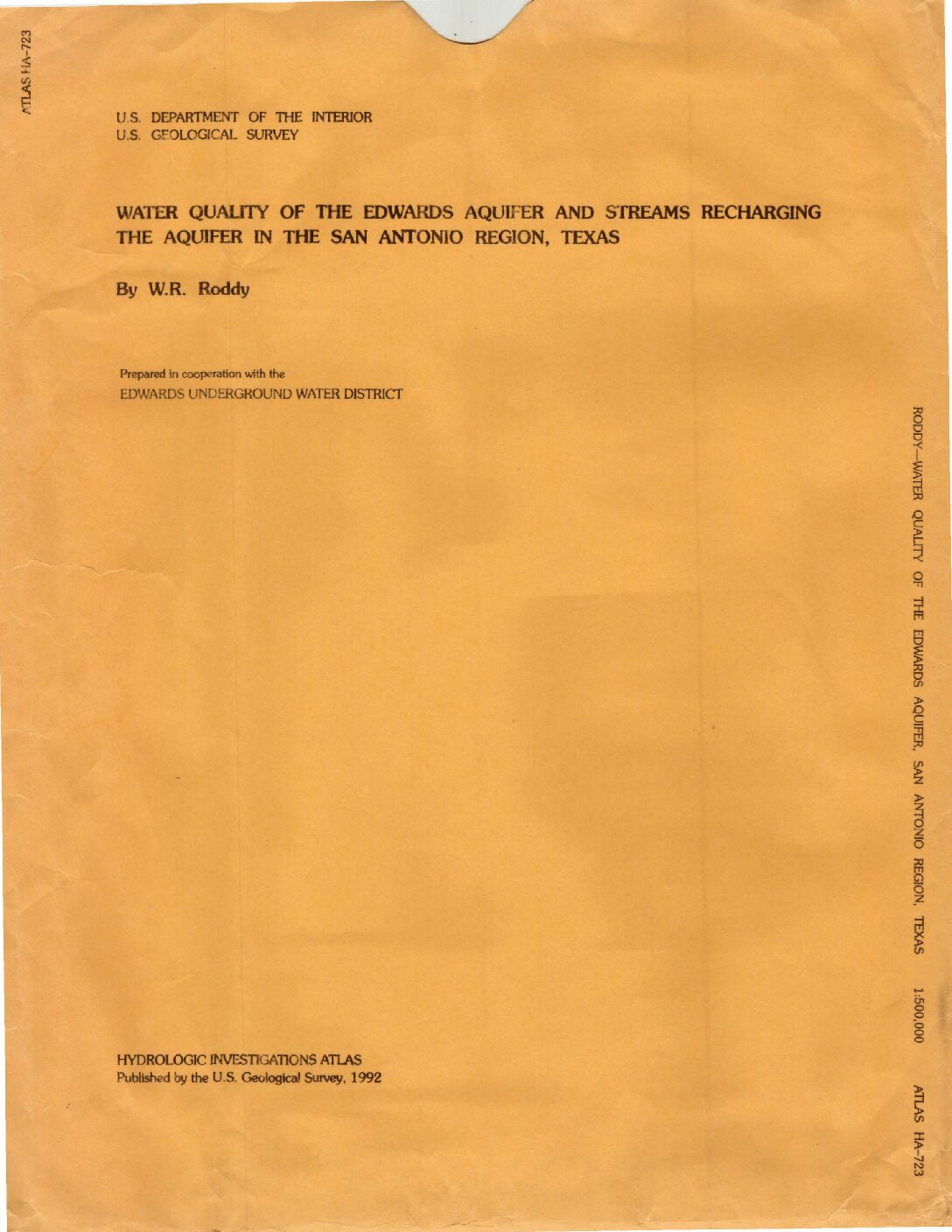
Description: Low-resolution maps and discussion of water quality in the Edwards Aquifer Balcones Fault Zone San Antonio Segment. Note: file size for full-size maps is too large.
Report Number: USGS Hydrologic Investigations Atlas HA-723
Location: Edwards Aquifer Balcones Fault Zone San Antonio Segment
Summary:Low-resolution maps and discussion of water quality in the Edwards Aquifer Balcones Fault Zone San Antonio Segment. Note: file size for full-size maps is too large.
Chemical and Bacteriological Quality of Water at Selected Sites in the San Antonio Area, Texas August 1968-January 1975

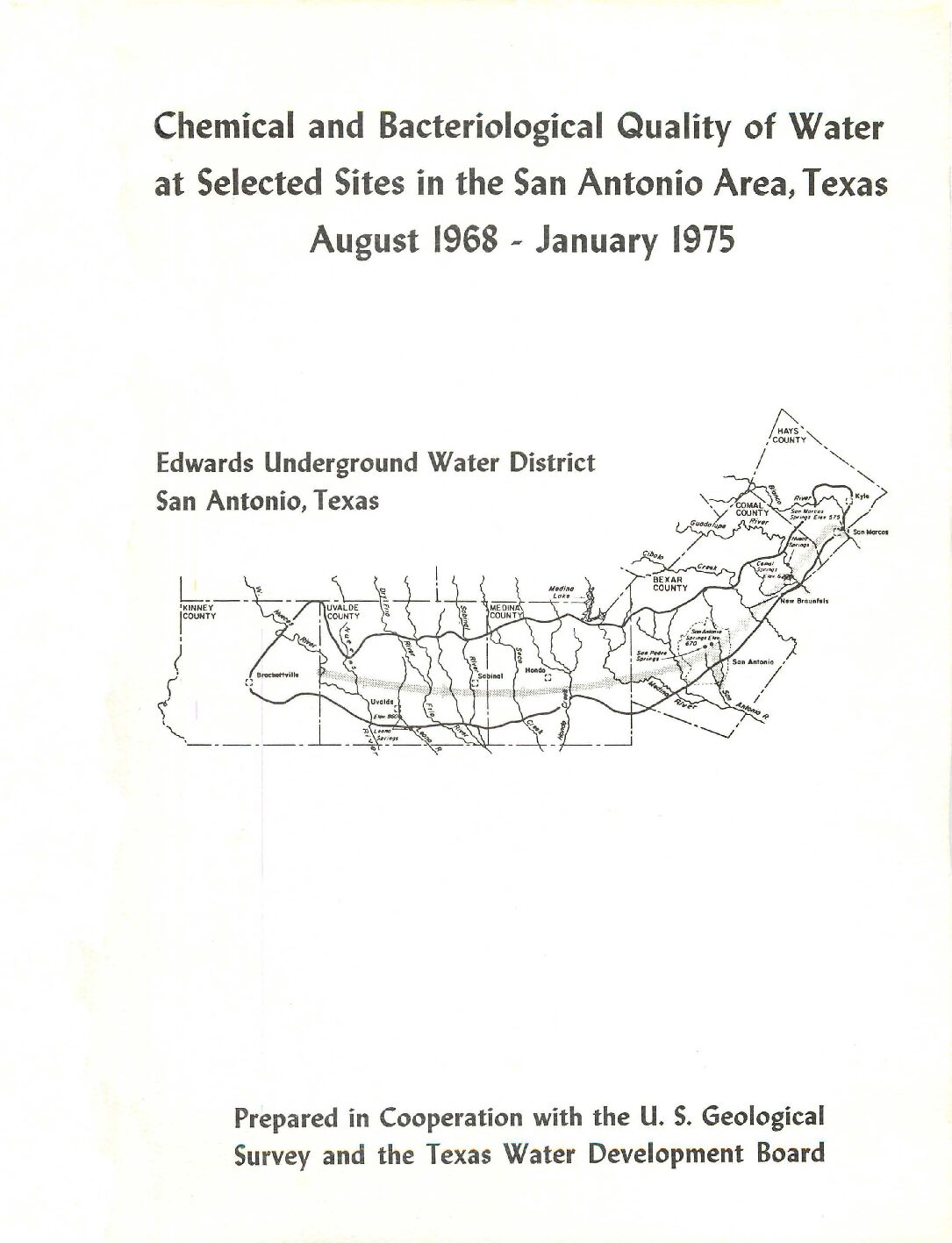
Description: Surface and groundwater quality monitoring in the San Antonio area, 1968-1976. Note: Page-size and full-size plates are at the end of the document.
Location: Edwards Aquifer, Balcones Fault Zone, San Antonio Segment, and associated surface water
Summary:Water samples collected from 161 wells and 3 springs in the Edwards aquifer and at 36 sites on streams that cross the recharge zone of the aquifer were analyzed for more than 50 properties or constituents, most of which affect the suitability of the water for domestic use. The samples were analyzed for bacteria; major inorganic constituents; minor elements, including heavy metals; pesticides; and several other properties or constituents.
None of the concentrations of major inorganic constituents, minor elements, or pesticides exceeded the U.S. Environmental Protection Agency's maximum contaminant levels for public water systems or maximum.acceptable limits for raw water used for drinking-water supplies. The concentrations of dissolved solids in samples from wells and springs ranged from about 200 to 527 mg/l (milligrams per litre) and the dissolved chloride and dissolved sulfate concentrations ranged from 3.7 to 130 mg/l and from 0.0 to 83 mg/l, respectively. The total nitrite plus nitrate nitrogen and total phosphorus concentrations in the ground water ranged from 0.00 to 5.5 mg/l and from 0.00 to 0.12 mg/l. The water is very hard (greater than 180 mg/l as calcium carbonate) and is of the calcium bicarbonate type.
The recharge zone or water-table part of the aquifer is characterized by areas of thin soils or bare rock, and the aquifer is susceptible to contamination in these areas. The presence of fecal coliform and fecal streptococci bacteria, the variations in the number of total coliform bacteria, and the concentrations of total nitrite plus nitrate nitrogen and total phosphorus in samples from some wells in the water-table part of the aquifer show that contamination can and does occur. However, the data indicate that such contamination at the present time (1976) is very localized, and is small in comparison to the volume of water available for dispersion and dilution. In the artesian zone of the reservoir, samples from improperly constructed wells have contained coliform bacteria; but samples collected from properly constructed and sealed wells were free of coliform bacteria.
There is no evidence of significant degradation of water quality throughout most of the ground-water reservoir, but the data collected during this study indicate that the nearly unrestricted movement of liquids· from the surf ace to the aquifer in the recharge zone presents an ever-present hazard if surface spills of toxic substances should occur. In addition, the many poorly-constructed wells in the artesian part of the aquifer could allow toxic substances to enter the aquifer.
Chemical and Bacteriological Quality of Water at Selected Sites in the San Antonio Area, Texas August 1968-April 1972


Description: Surface and groundwater quality monitoring in the San Antonio area, 1968-1972
Location: Edwards Aquifer, Balcones Fault Zone, San Antonio Segment, and associated surface water
Summary:Urban development on or adjacent to the recharge zone of the Edwards aquifer is causing concern about the possible pollution of ground water in the aquifer, which is the principal source of water supply for the San Antonio area. Water-quality data for many wells and springs and for selected sites on streams that cross the recharge zone of the aquifer are being collected to provide background information and to detect any current pollution of ground water in the area.
Water from the Edwards aquifer is very hard and of the calcium bicarbonate type. The concentrations of dissolved solids in samples from wells and springs ranged from about 200 to 470 mg/1 (milligrams per liter); the chloride and sulfate concentrations ranged from 6.5 to 62 mg/1 and from 0.0 to 65 mg/1, respectively. The nitrate and phosphate contents of the ground water ranged from 0.0 to 15 mg/1 and from 0.00 to 0. 37 mg/1.
The concentrations of these and other constituents show that the chemical quality of water in the Edwards aquifer has not been degraded significantly by domestic, industrial, or agricultural effluents.
However, variations in the number of coliforms, the concentrations of nitrate and phosphate, and the presence of fecal coliforms and fecal streptococci in samples from some wells show that fecal pollution is reaching the aquifer.
Most of these wells, which are located in or just downdip from the recharge zone, are poorly sealed or inadequately cased. The areal variation in the locations of these wells indicates that pollution of ground water in the aquifer is very localized. Pollution results principally from runoff from the land surface and from effluent from septic tanks which enters the aquifer through fractures in the recharge zone or which infiltrates through the thin soil into poorly sealed or inadequately cased wells in or adjacent to the recharge zone.
Trace amounts of several pesticides have been detected in samples from two wells in the San Antonio area. Field investigations showed the source of pesticides in these wells to be. surface drainage that entered the wellbores.
Water-quality data collected at sites on streams that cross the recharge zone of the Edwards aquifer show the chemical composition of surface water to be very similar to that of ground water in the area.
Water in most streams is very hard and of the calcium bicarbonate type. Limited data on the bacteriological quality show that coliforms were present at each of the sites sampled and that fecal coliforms and fecal streptococci were present at most sites. Although the number of these bacteria varied greatly in both time and place, their density in samples from most sites were low for untreated surface water.
Analysis of Water Quality Data for East Elm, West Elm and Lorence Creeks

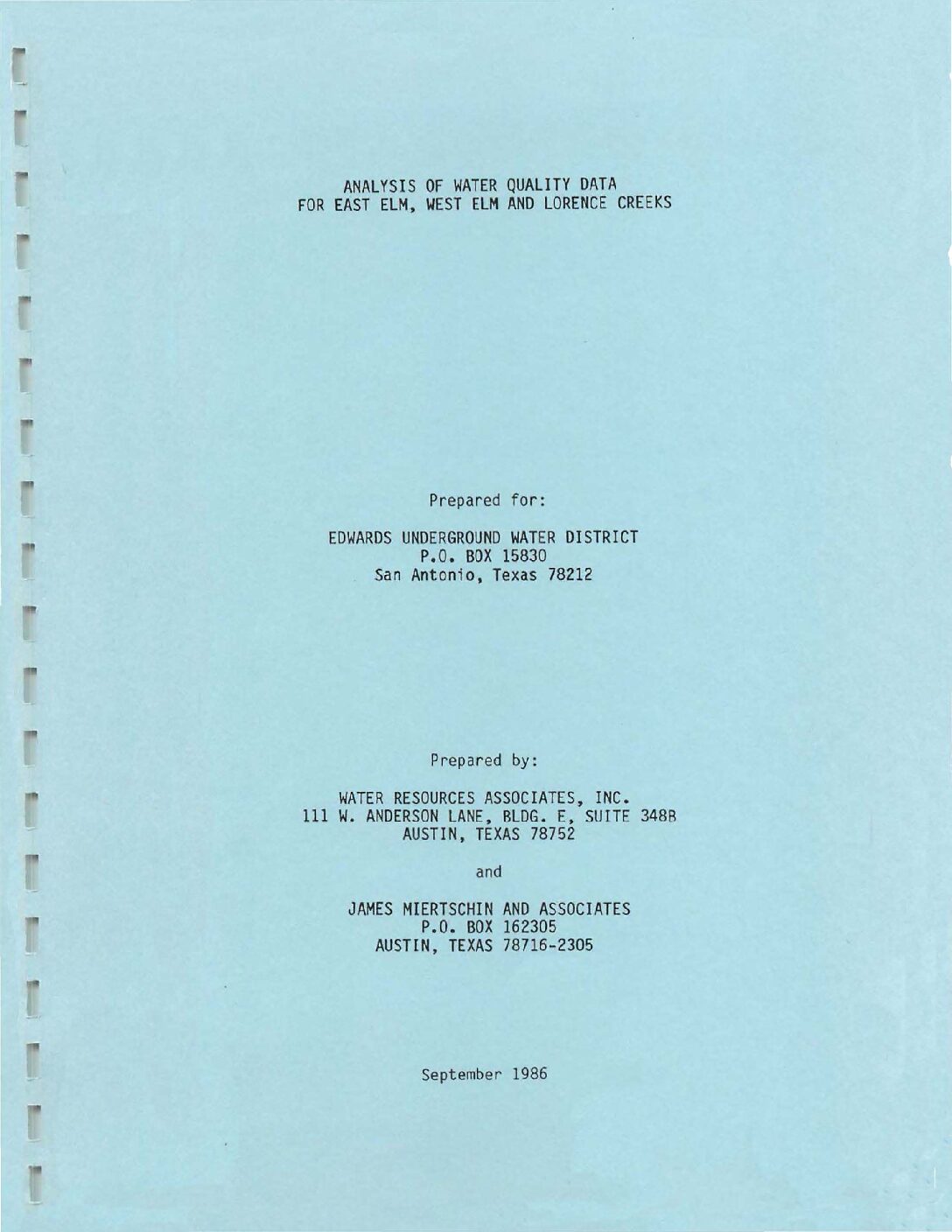
Description: Water quality in three small watersheds in the Edwards Aquifer Recharge Zone in relation to storm water runoff and urbanization, 1976 - 1980
Location: Edwards Aquifer, Balcones Fault Zone, San Antonio Segment, Recharge Zone
Summary:Water quality data collected on East Elm, West Elm and Lorence Creeks were compiled and analyzed. The watersheds of the three streams are characterized by different levels of urbanization. The East Elm watershed is largely undeveloped, while the Lorence Creek basin is almost completely urbanized as a residential area. The West Elm watershed represents an intermediate level of development.
Statistical analysis of the water quality data indicated that mean concentration values of most of the constituents were higher at the Lorence Creek station than at either the East Elm or West Elm sites. Further, mean concentration values at the West Elm station were higher than corresponding values at the East Elm station.
The most apparent factor which may contribute to the observed differences in constituent concentrations is the level of urbanization in the test watersheds. However, additional factors could also contribute, such as physiographic variables and differences in the frequency and duration of stormwater runoff events. On the basis of flow-weighted average concentrations, West Elm Creek displayed the highest values, with no consistent difference evident between Lorence Creek and East Elm Creek.
Several mathematical relationships were examined to investigate correlations between constituent concentration and discharge rate for the three sampling stations. Only poor correlations were evident, indicating that concentrations are not a function of flow rate.
Chemical Analyses of Water from Observation Wells in the Edwards and Associated Limestones, San Antonio Area, Texas, 1967

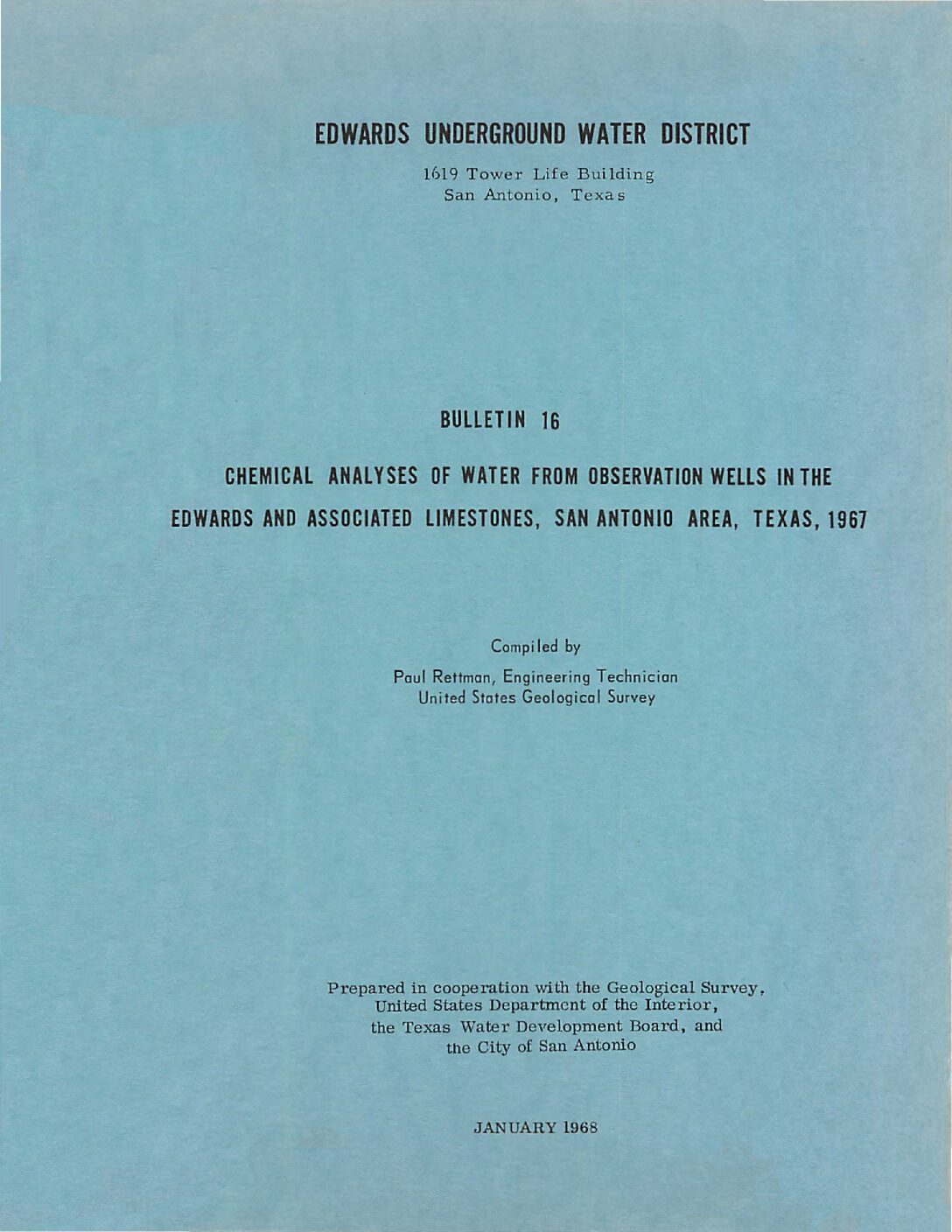
Description: Chemical analyses of water from 37 wells to define the boundary of the freshwater-saline water interface in the Edwards Aquifer Balcones Fault Zone San Antonio segment in 1967. Note: This report is included for its historical value; results may have been superseded by more recent studies.
Report Number: Bulletin 16
Location: Freshwater/Saline Interface, Edwards Aquifer Balcones Fault Zone San Antonio Segment
Summary:Note: This report is included for its historical value; results may have been superseded by more recent studies.
A program to resample observation wells tapping a zone of transition between water of good quality and saline water in the Edwards and associated limestones was begun in 1959. The chemical analyses of the resampling program are being used to detect possible encroachment of saline water into the fresh-water areas as the head in the aquifer changes. Those analyses compiled through 1966 were published by the Edwards Underground Water District (See references, page 3), and this report presents the chemical analyses compiled during 1967. This program is part of a more extensive hydrologic investigation carried on by the U. S. Geological Survey in cooperation with the Edwards Underground Water District, the Texas Water Development Board, and the city of San Antonio.
Samples are collected for chemical analyses from 37 wells, most of which are sampled twice a year, but some are sampled only once a year because of their limited use. The number of wells was reduced in 1966 from 72 to 37, but the original 72 will be sampled again when water levels drop to those levels near and below the recorded lows.
The well numbers in this report conform to the statewide system used by the Texas Water Development Board (Alexander and others, 1964). The numbers formerly used are listed in parenthesis with each well. The water samples are analyzed in the laboratory of the U.S. Geological Survey in Austin, Texas, for specific conductance, pH, chloride, sulfate, bicarbonate, and hardness. A more complete analysis has been made for one sample from each well, and these analyses are on file in the offices of the Geological Survey in Austin and San Antonio. Locations of wells and other data pertaining to the resampling program may be found in the references.
Conceptualization and Simulation of the Edwards Aquifer, San Antonio Region, Texas

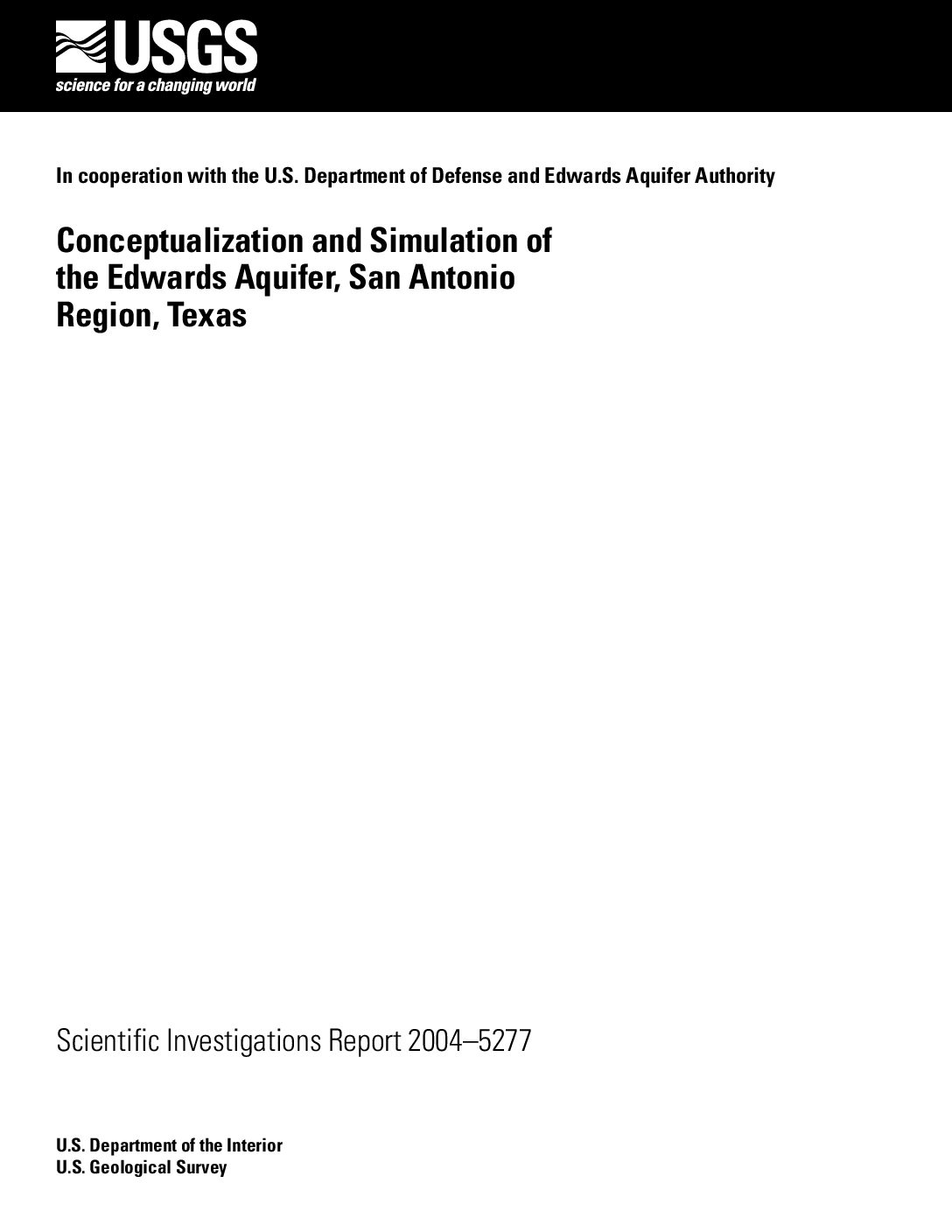
Description: A new ground-flow model for the San Antonio and Barton Springs segments in the San Antonio region. Note: this document is included for its historical value and may have been replace by more recent updates.
Report Number: USGS SIR 2004-5277
Location: Edwards Aquifer, San Antonio and Barton Springs Segments excluding Travis County
Summary:Note: this document is included for its historical value and may have been replace by more recent updates.
A new numerical ground-water-flow model (Edwards aquifer model) that incorporates important components of the latest information and plausible conceptualization of the Edwards aquifer was developed. The model includes both the San Antonio and Barton Springs segments of the Edwards aquifer in the San Antonio region, Texas, and was calibrated for steady-state (1939“46) and transient (1947“2000) conditions, excluding Travis County. Transient simulations were conducted using monthly recharge and pumpage (withdrawal) data.
The model incorporates conduits simulated as continuously connected (other than being separated in eastern Uvalde and southwestern Medina Counties), one-cell-wide (1,320 feet) zones with very large hydraulic-conductivity values (as much as 300,000 feet per day). The locations of the conduits were based on a number of factors, including major potentiometric- surface troughs in the aquifer, the presence of sinking streams, geochemical information, and geologic structures (for example, faults and grabens).
The simulated directions of flow in the Edwards aquifer model are most strongly influenced by the presence of simulated conduits and barrier faults. The simulated flow in the Edwards aquifer is influenced by the locations of the simulated conduits, which tend to facilitate flow. The simulated sub-regional flow directions generally are toward the nearest conduit and subsequently along the conduits from the recharge zone into the confined zone and toward the major springs. Structures simulated in the Edwards aquifer model influencing groundwater flow that tend to restrict flow are barrier faults. The influence of simulated barrier faults on flow directions is most evident in northern Medina County.
A water budget is an accounting of inflow to, outflow from, and storage change in the aquifer. For the Edwards aquifer model steady-state simulation, recharge (from seepage losses from streams and infiltration of rainfall) accounts for 93.5 percent of the sources of water to the Edwards aquifer, and inflow through the northern and northwestern model boundaries contributes 6.5 percent. The largest discharges are springflow (73.7 percent) and ground-water withdrawals by wells (25.7 percent).
The principal source of water to the Edwards aquifer for the Edwards aquifer model transient simulation was recharge, constituting about 60 percent of the sources of water (excluding change in storage) to the Edwards aquifer during 1956, a drought period, and about 97 percent of the sources (excluding change in storage) during 1975, a period of above-normal rainfall and recharge. The principal discharges from the Edwards aquifer for the transient simulation were springflow and withdrawals by wells. During 1956, representing drought conditions, the change in storage (net water released from storage) was much greater than recharge, accounting for 75.9 percent of the total flow compared to 14.5 percent for recharge.
Conversely, during 1975, representing above-normal rainfall and recharge conditions, recharge constituted 79.9 percent of the total flow, compared to 7.1 percent for the change in storage (net water added to storage).
A series of sensitivity tests was made to ascertain how the model results were affected by variations greater than and less than the calibrated values of input data. Simulated hydraulic heads in the Edwards aquifer model were most sensitive to recharge, withdrawals, hydraulic conductivity of the conduit segments, and specific yield and were comparatively insensitive to spring-orifice conductance, northern boundary inflow, and specific storage. Simulated springflow in the Edwards aquifer model was most sensitive to recharge, withdrawals, hydraulic conductivity of the conduit segments, specific yield, and increases in northern boundary inflow and was comparatively insensitive to spring-orifice conductance and specific storage.
Geophysical Survey to Determine the Depth and Lateral Extent of the Leona Aquifer and Evaluation of Discharge Through the Leona River Floodplain, South of Uvalde, Texas

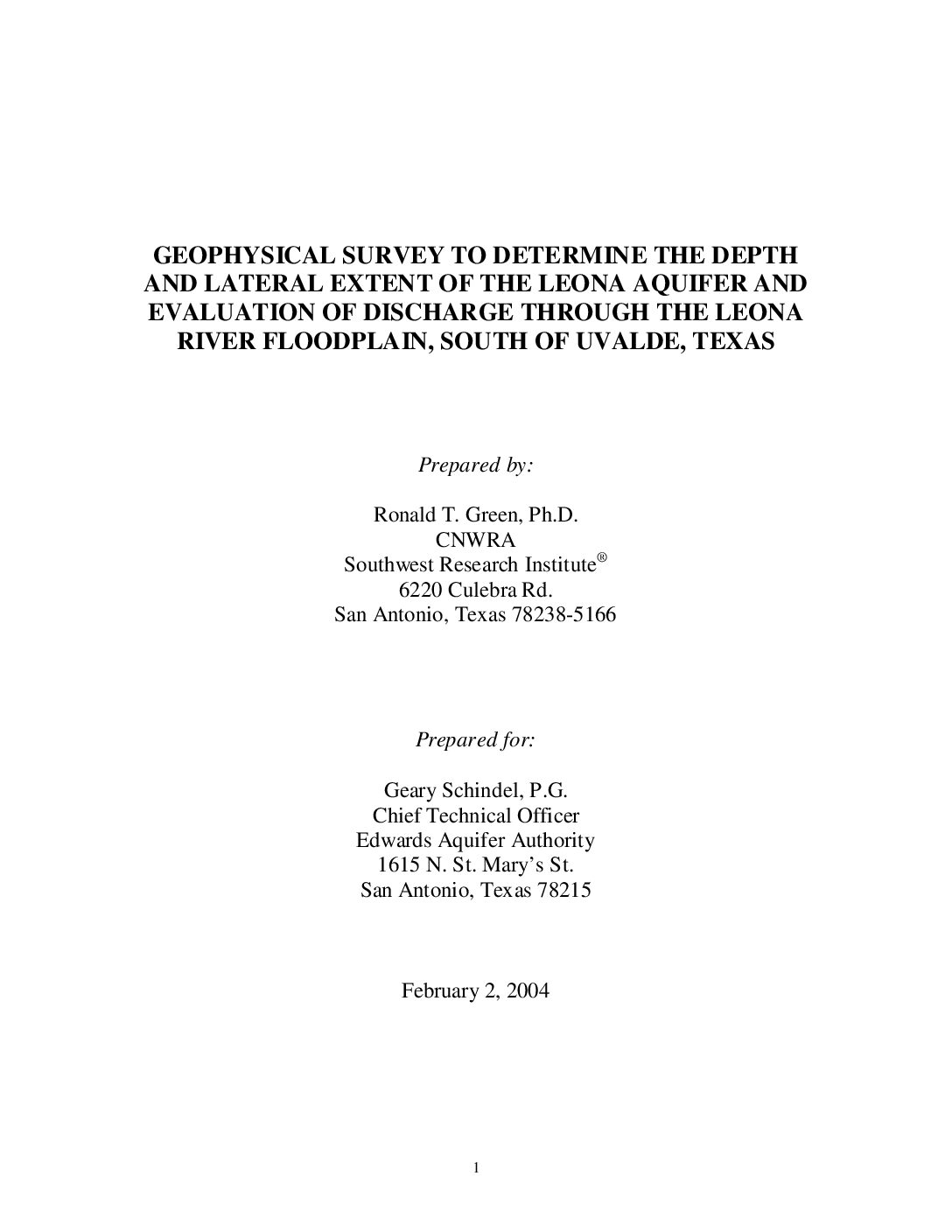
Description: Determination of groundwater flow regime for the Leona Formation aquifer in the Leona River floodplain
Location: Leona River
Summary:The purpose of this study was to evaluate the depth and lateral extent of the Leona Formation. This data was combined with previously determined Leona Aquifer parameters to estimate the amount of water that may be flowing from the Edwards Aquifer in the area of Leona Springs. This information will improve the overall understanding of the Edwards Aquifer hydrologic budgets. The project report concludes that there may be as much as 100,000 acre feet of water leaving the Edwards Aquifer in the vicinity of Leona Springs.
Accurate assessment and management of the groundwater resources of the Edwards aquifer require that major sources of water recharge into and discharge from the aquifer be adequately determined. Of interest in this investigation is discharge from the Edwards aquifer as surface water or groundwater flow through the Leona River channel which crosses the aquifer. River channel discharge from the aquifer will only occur in places where the Edwards aquifer is unconfined, no significant thicknesses of impermeable materials separate the river channel from the aquifer, and the static level of groundwater
in the Edwards aquifer is higher than the base of the river channel surface or higher than the surface of groundwater flow in the floodplain aquifer.
River channels such as those of the Nueces or Frio Rivers (Figure 1) which cross the Edwards aquifer west and east of the Leona River, respectively, do not have sufficient floodplain sediments for a significant fluvial aquifer. Among these river channels, discharge from the Edwards Aquifer is limited to possible surface (or minimal shallow subsurface) water flowing through the river channel. Water recharge into or discharge from the Edwards Aquifer via rivers such as the Frio and Nueces is determined by calculating gains or losses along a reach of the river using stage and flow measurements.
The Leona River floodplain differs from those of the Frio and Nueces Rivers. The Leona River floodplain consists of relatively thick (i.e., as great as 70-80 ft) sediments that span a width as great as three miles in places. The sediments, part of the Leona Formation, contain significant sand and gravel paleo-streambed deposits that form the Leona aquifer, which can be a locally prolific aquifer. The potential high capacity for groundwater flow may make the Leona River floodplain a significant area of discharge from the Edwards Aquifer. To determine the quantity of groundwater flow through the Leona aquifer, the depth, lateral extent, hydraulic properties, and groundwater gradient must be known or at least reasonably estimated.
A dipole-dipole resistivity survey was conducted in March 2003 to determine the depth and lateral extent of the sand and gravel deposits in the Leona River floodplain. This information was combined with borehole logs, a potentiometric map of groundwater, and the results from a 10-day aquifer test to determine the groundwater flow regime of the Leona Formation aquifer in the Leona River floodplain. The groundwater flow regime was used, in turn, to constrain a conceptual model for groundwater flow through the
Knippa Gap portion of the Edwards Aquifer.
A Statistical Study of the Hydrological Character of the Edwards Aquifer

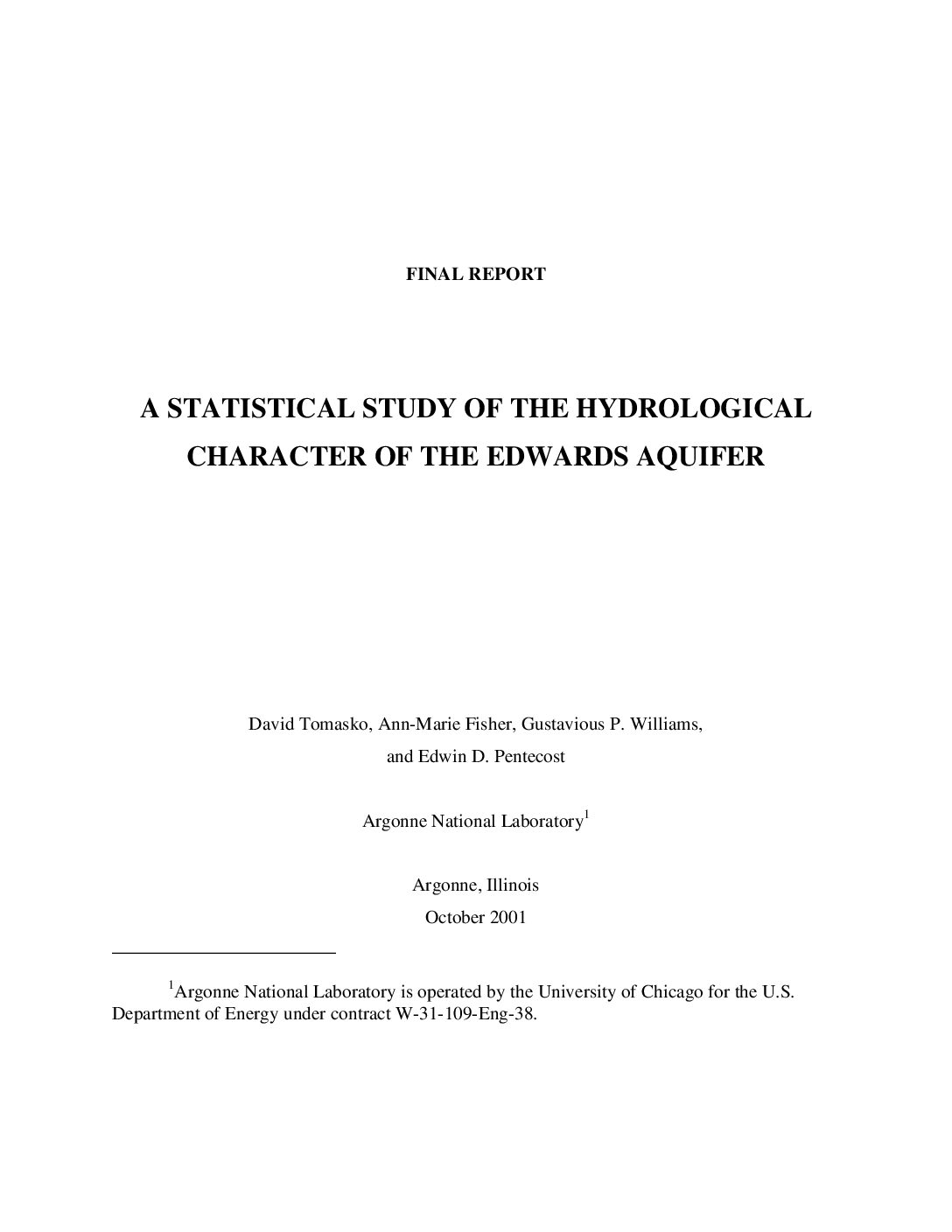
Description: Statistical analysis of surface and groundwater levels from October 1998 storm event
Location: Edwards Aquifer, Balcones Fault Zone, San Antonio Segment
Summary:The purpose of this study was to evaluate Edwards Aquifer“related hydrologic data from the October 1998 storm event. Surface water and groundwater levels were statistically analyzed to evaluate responses of the aquifer to the major recharge event. The study was completed in November 2001 by Argonne National Laboratory, Argonne, Illinois.
An analysis was performed on data from the October 1998 precipitation in the area of the Edwards Aquifer. Lag times and cross-correlation coefficients were found for the independent variables, including spring flow and water levels in monitor wells. Conclusions derived from the measured data include the following:
- Most of the precipitation from the October 1998 event fell on the eastern portion of the Edwards Aquifer area. This finding is consistent with published information from the USGS.
- Response of river and stream flow to the precipitation event were very rapid and produced sharp peaks in flow with fast recession curves. Because hourly data were not available for the rivers or streams, the storm surge could not be tracked downstream.
- Responses of flows from San Marcos and Comal Springs were rapid, indicating a strong connection with surface water. Peak flows were achieved at San Marcos and Comal Springs in 9 and 11 days, respectively. Because hourly data were not available, the peak could not be further delineated. The more rapid rise to peak flow in San Marcos Springs is indicative of a smaller watershed or a higher transmissivity aquifer.
- Flows in San Marcos and Comal Springs returned to their pre-event values after 166 and 220 days, respectively. The longer recession at Comal Springs may be caused by a larger watershed, a lower transmissivity, or a combination of both.
- The recession curve for flow from San Marcos Springs has a pronounced flat period that starts about 20 days after the rainfall event and lasts about 35 days. The slope of the recession curve is about the same for earlier and later times. This behavior may indicate that there is a substantial storage in the Edwards Aquifer at a depth less than that of peak conditions, or that flow may be arriving from outside its watershed. For the latter case, the travel time is about 20 days.
- Cross-correlation between flows from San Marcos and Comal Springs was very good. Filtering the field data with a moving average window did not significantly improve the results. Similarly, significant improvements were not produced by taking a log transformation of the field data. Maximum cross-correlations were obtained for a zero-day lag time. This finding is consistent with a conceptual model in which there is strong communication with surface water (rivers, streams, and runoff).
- Water levels in monitor wells in the northern portion of the Edwards Aquifer area had very high cross-correlation coefficients, as did water levels in wells in the southern portion of the area. Cross-correlations, however, between water levels in wells in the northern and southern portions of the aquifer were, in general, low.
This finding is consistent with the wells' being completed similarly in the recharge and fresh-water zones, and, as with all statistical correlations, the results may be fortuitous.
- A four-parameter linear regression model demonstrated that inclusion of time series data from the Blanco River was not warranted because of its very high and rapid runoff response to the precipitation event.
- The best overall four-parameter model included flow from Comal Springs and water levels in monitor wells J-17 and Quihi.
- More complex models that include more than four estimated parameters could be constructed, but the inclusion of additional parameters is questionable.
- Results of the model may not be applicable for analysis of other, lower flows because the linear regression model was developed for flood conditions.
Measuring Floodplain Hydraulics of the Frio River Where it Overlies the Edwards Aquifer

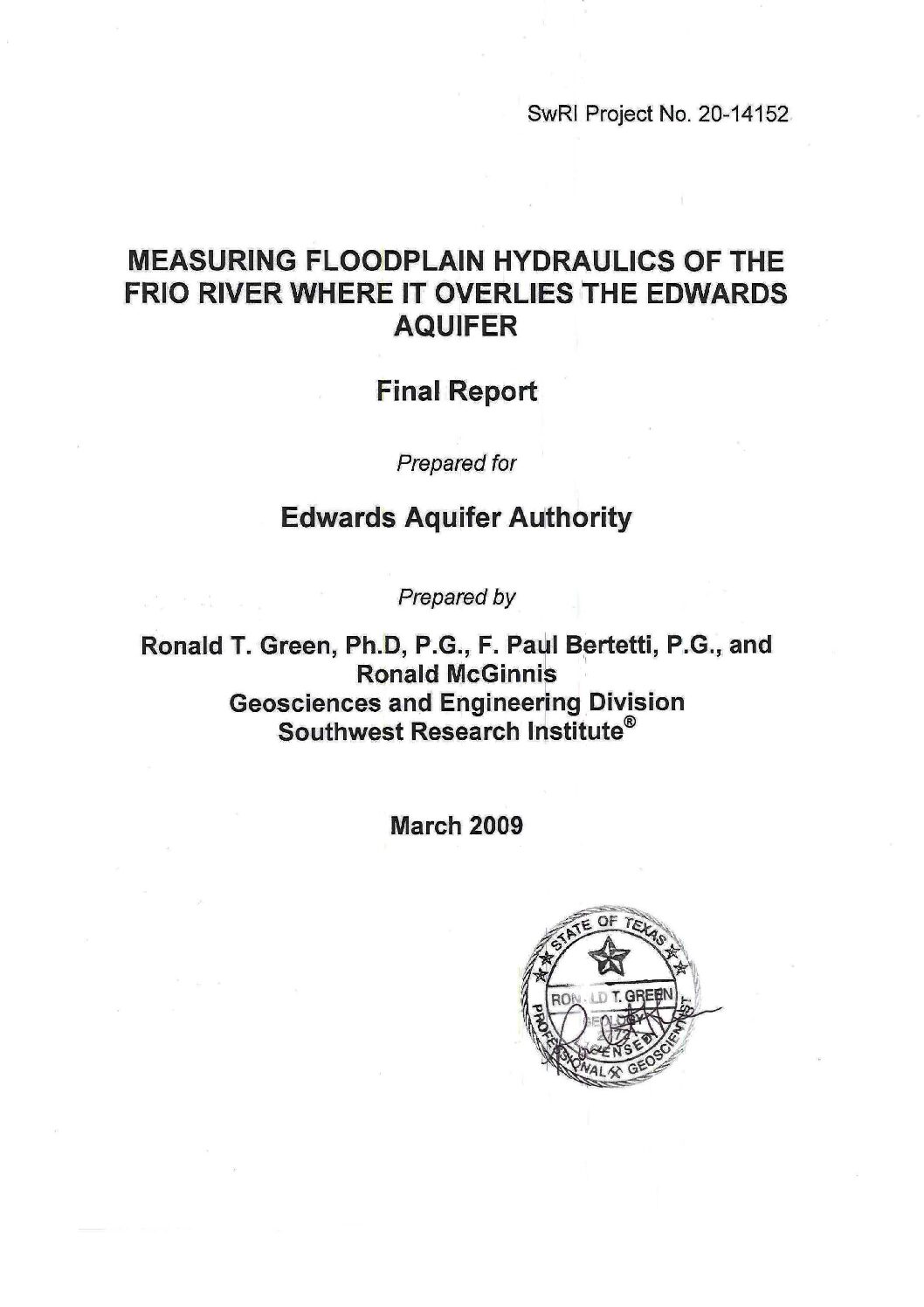
Description: Structural and hydrogeological survey of the Frio River to determine if water table underflow contributes to the water budget of the Edwards Aquifer Recharge Zone
Report Number: 20-14152
Location: Frio River, Dry Frio River, Edwards Aquifer Recharge Zone
Summary:The purpose of this study was to reduce uncertainty in recharge calculations involving the Frio and Dry Frio rivers by investigating their hydraulic relationship with the Edwards Aquifer. Geophysical imaging of the subsurface of the floodplains of the Dry Frio River and the Frio River did not detect evidence of significant subsurface flow through either paleo-channel deposits or preferential flow pathways developed in the bedrock. In addition, nearby waterholes and wells contain water from infiltrating rainfall and river flow events or upward leakage of relatively saline water. The source of the water is either the Edwards Aquifer or the Austin Chalk rather than subsurface water flowing in the floodplain. Consequently, surface water gauging of river flows in the Frio and Dry Frio Rivers accurately represents the true volume of recharge of the Edwards and related aquifers by recharge in the river channels. The study was completed in May 2009 by Southwest Research Institute, San Antonio, Texas.
[Excerpted from the report's Conclusions]
[T]he Frio and Dry Frio Rivers are assumed (Hamilton et al., 2008) to be hydraulically connected with the Edwards Aquifer in the Edwards Aquifer recharge zone. Both rivers exit the recharge zone about six miles north of the City of Knippa. There is no evidence of underflow in the Frio and Dry Frio River floodplains. This indicates that surface water flow gauging, if performed immediately before and after the rivers enter and exit the recharge zone, should accurately represent the amount of water recharged to the Edwards Aquifer. Supporting this conceptualization is that the source water for all four waterholes is interpreted to be from depth as springs and that there is no indication of floodplain underflow.
Edwards/Glen Rose Hydrologic Communication, San Antonio Region, Texas

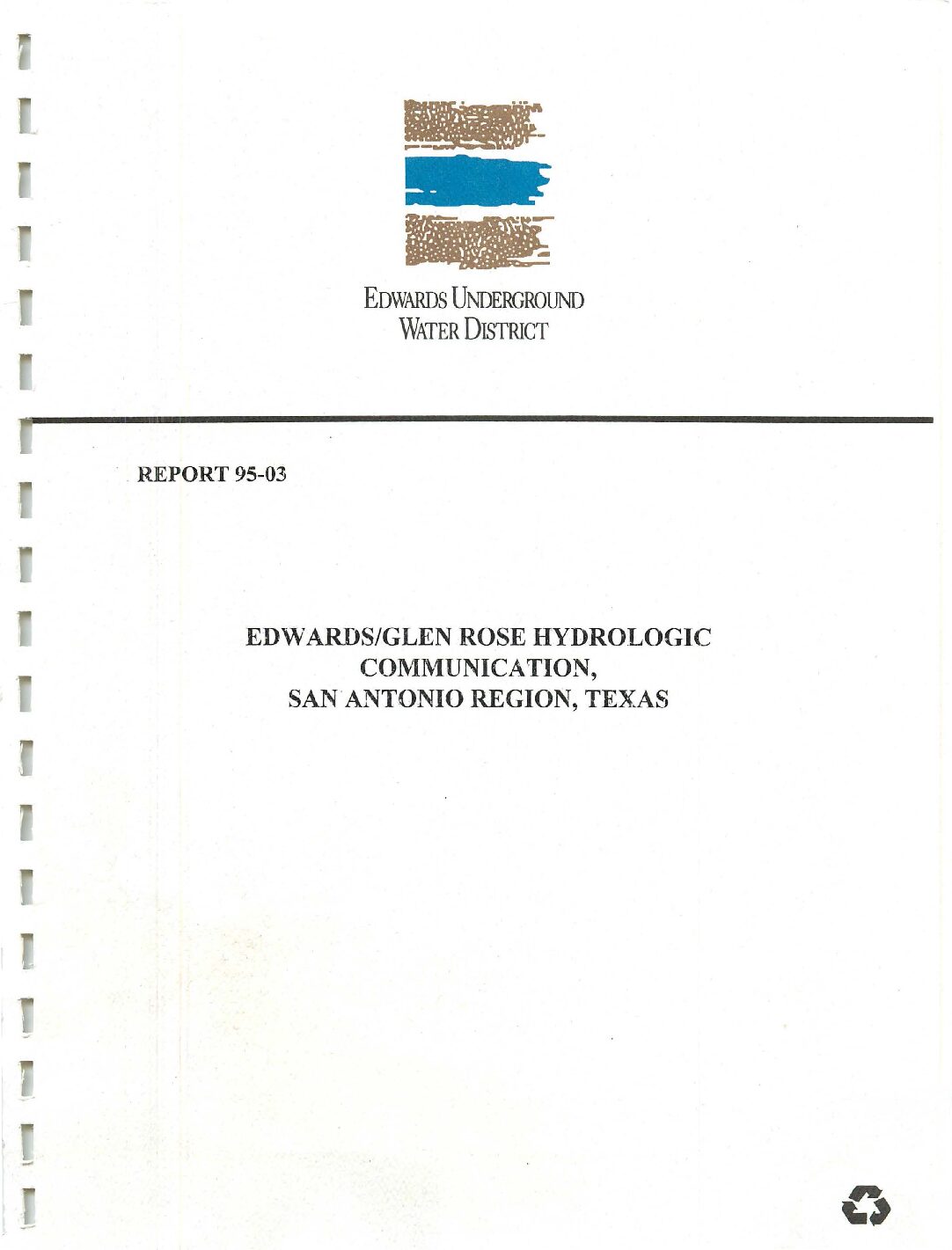
Description: Hydrogeological and modeling study of transmissivity between the Glen Rose and Edwards aquifers in the Cibolo Creek Basin and Guadalupe River
Report Number: 95-03
Location: Edwards Aquifer Balcones Fault Zone San Antonio Segment, Glen Rose Aquifer, Cibolo Creek Basin, TX
Summary:This report presents the results from a study conducted to evaluate and estimate the amount of water that might move directly from the Glen Rose aquifer into the Edwards aquifer in the San Antonio region. Three main approaches were used for identifying hydrologic communication and the potential amount of flow between the Glen Rose and the Edwards aquifers: (1) geologic evidence, (2) hydrologic evidence and (3) hydrochemical evidence. The geologic and hydrologic evidence was used both on a site-specific area (Haby Crossing fault area) and regionally to determine quantities of inflow from the Glen Rose.
Hydrologic communication between the Glen Rose and Edwards aquifers in the Cibolo Creek basin has previously been considered different from water transfers between the two aquifers elsewhere. Historically, recharge to the Edwards aquifer in Cibolo Creek basin has been calculated using stream losses from Boerne to Bracken, even though lower Glen Rose is exposed in the creek between Boerne and Bulverde.
Based principally on stream-loss records, available water-level records and the absence of a previously known discharge area, recharge has been assumed to enter the Edwards aquifer as underflow from the Glen Rose Formation in the subsurface through a shallow karst system under Cibolo Creek. However, mapping of the extent of Honey Creek Cave, northeast of Cibolo Creek in this area, and hydrogeologic observations indicate that some water is diverted through cave conduits to the Guadalupe River. As a result, the large stream losses in Cibolo Creek over the lower Glen Rose member previously used to calculate Edwards aquifer recharge may not find its way to the Edwards aquifer unless the water is recharged in the Guadalupe River basin.
The Haby Crossing fault area, because of the relatively large fault displacement, is one of the best locations for the Edwards and Glen Rose Limestones to be juxtaposed to one another, which gives the best potential for hydrologic communication between the two aquifers. Based on calculations from water-level and pumping-test data, it is estimated that about 360 acre-feet per year (ac-ft/yr) of inflow could be transmitted to the Edwards aquifer along a 14-mile length of the Haby Crossing fault under 1994 water-level conditions. This amount is relatively small compared to the average calculated direct recharge in the Medina River basin (about 61,000 ac-ft/yr, as calculated by the U. S. Geological Survey) and the average total aquifer recharge (about 682,800 ac-ft/yr) for the Edwards aquifer in the San Antonio region. Geochemical modeling confirms that only small amounts of Glen Rose water are entering the Edwards aquifer as compared to other recharge sources, possibly on the order of 5 percent of the total water immediately downgradient of the Haby Crossing fault. This initial mix of Edwards and Glen Rose water continues to be diluted as the water travels downgradient toward the main artesian part of the Edwards aquifer near San Antonio. Based on geochemical models using NETPATH and median chemical values, the chemical content of water representative of the Edwards aquifer in the San Antonio region is diluted to less than 1 percent Glen Rose water as compared to the total water content.
Regionally, underflow from the Glen Rose Formation to the Edwards aquifer along the Balcones fault zone can occur by ground water moving laterally in a downgradient direction within the Glen Rose and entering the Edwards aquifer through fault planes. The amount of ground water in transit is dependent on the length of the line of entry (fault plane) through which water enters the Edwards aquifer, the water level gradient across the fault plane from the Glen Rose to the Edwards aquifer, and the effective transmissivity for the Glen Rose aquifer upgradient and along this line.
Using this method, which excludes recharge in Cibolo Creek through the lower Glen Rose to the Edwards and contributions from the Edwards-Trinity Plateau aquifer at the western end of the aquifer, an approximate range of total Glen Rose underflow to the Edwards aquifer would be about 2, 700 to about 11,400 ac-ft/yr in the San Antonio region. These estimates are based on high and low median transmissivities and a positive water-level gradient from the Glen Rose to the Edwards aquifer. As compared to the total Edwards aquifer water budget, these estimates indicate that the Glen Rose contribution is probably less than 2 percent of the total water budget during average recharge conditions.
Medina Lake Hydrology Study

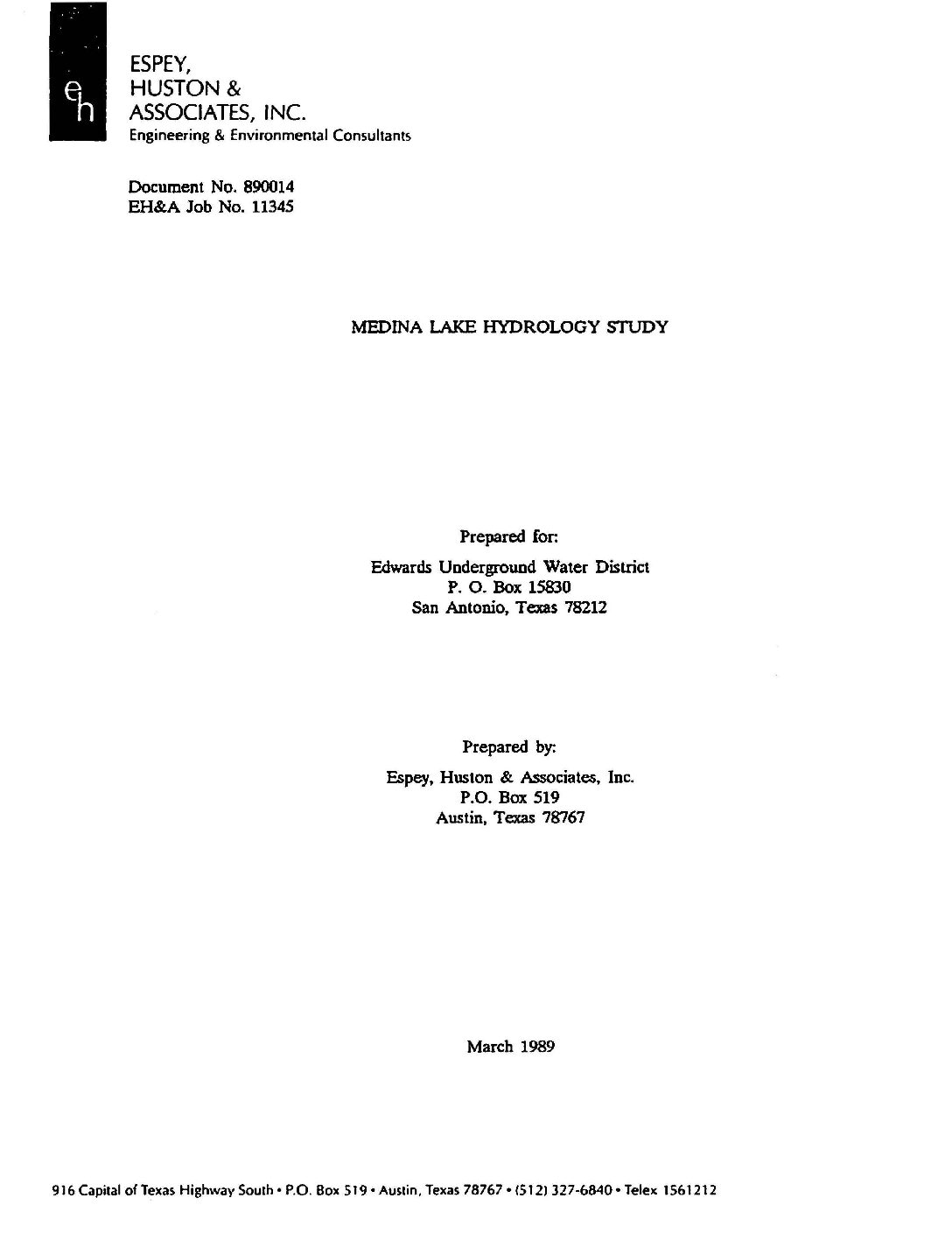
Description: Hydrologic and hydraulic analyses for the Medina Lake and Medina Diversion Lake reservoir system
Report Number: 890014
Location: Medina Lake, Medina Diversion Lake
Summary:This report presents the results of hydrologic and hydraulic analyses for the Medina Lake and Medina Diversion Lake reservoir system. This engineering analysis was conducted in order to determine the availability of surface water from these reservoirs under various operating scenarios for the purpose of recharge to the Edwards Aquifer. Also included in the project objective was an engineering analysis of the hydraulic capacity of each of these facilities under a variety of flood conditions.
The Medina Lake inflows, recharge and seepage curves and historical diversions were used in the reported diversions Scenario 1 with a starting elevation at 1,064.1 feet NGVD. The resulting end-of-month elevations and contents were then compared to the actual historical values for Medina Lake given in Tables 3-2 and 3-3 (TWC, 1980 and US WEST, 1988). A plot of the end-of-month elevations in Figure 3-3 shows that the actual elevation values for the 1940 to 1957 period were lower than the elevations given by the computer simulation for Scenario 1.
This result was investigated further by re-running Scenario 1 with the starting elevation at the historical level in January 1940. The results were similar to those above. However, since the elevations for the historical and simulated cases were very close for the 1957 to 1986 period (when the inflows and canal diversions were based on more reliable, gaged information), it was concluded that the recharge and seepage relationships discussed in Section 3.2 were providing remarkably close results to those observed historically, and could be adopted for use without further evaluation.
The Medina Lake inflows were then verified using a statistical correlation between the Guadalupe River Comfort gage and the Medina River Pipe Creek gage for the 39.5 years of data available at both gages. This analysis predicted a linear relationship between the flows at these gages with an R-squared value of 0.72. Since the average inflows calculated using the statistical equation discussed in this paragraph were larger than the average inflows calculated using the drainage area calculations described above, the original inflows were judged to be the most conservative and appropriate for use in this study. In addition, no justification could be found for lowering the initially computed inflow values.
One of the primary differences between the reservoir operations discussed in this report and the actual historical operation was the criteria used for diversions. Historically, the diversions were made for actual year-to-year irrigation requirements and were not directly dependent on the lake elevation for either the diversion rate or amount. When the scenarios evaluated in this report were operated, the diversion rates were based on the beginning of month elevation. In EH&A's opinion, the historical diversions through the Medina Canal during the 1940-1955 time period were much higher than those reported by BMA. Therefore, this discrepancy in the historical diversions was assumed to be the source of the end-of-month elevation discrepancy found using Scenario 1 (vs. actual historical) and Scenario 1 was discarded and not used for further analyses.
Scenarios 2 through 12 were then performed as described in Section 8.0 in order to evaluate the differences and impacts which can be attributed to the various different operating criteria evaluated in Section 8.0 for recharge purposes.
The conclusions which may be drawn from the results of the yield model are as follows:
1) The optimum reservoir system operation for recharge is to maximize the recharge during wet periods, sustain a constant level of recharge during normal years and to accept no recharge diversions during dry years. This type of operation was illustrated by scenarios 9, 11 and 12 without any correction for leakage.
2) Enhancement of natural recharge by ceasing diversions and maximizing the storage in the reservoir did not, comparatively speaking, prove to be a viable alternative, as demonstrated by Scenario 2. The natural recharge increased by an amount of 8,528 acre-feet per year over the recharge computed by EH&A to have occurred historically.
3) There was no annual demand which could be withdrawn from the reservoir system through the critical drought of record without significant shortages, i.e., there is no firm yield. Even with zero diversions, Medina Lake was drawn down below the outlet levels for 17 consecutive months during the 1949 to 1957 drought, due to evaporation, natural recharge and leakage. This is demonstrated by Scenario 3.
4) Leakage correction at the Diversion Dam will net an additional 4,500 acre-feet per year when the recommended minimum flows are provided downstream.
5) Leakage correction at the Main Dam will not increase the amount of water available for recharge. The Main Dam leakage rate at full level is approximately equal to the Diversion Lake recharge rate, diversions and minimum flows.
6) The flows to the San Antonio Bay were not significantly affected by the different scenarios tested. The maximum difference in bay inflows was observed between Scenario 2, No Diversions, and Scenario 10, Artificial Recharge/Minimum Flows/Leakage Correction. Scenario 2 had a bay inflow of 1,552, 271 ac-ft per year while Scenario 10 had a bay inflow of 1,517,214 ac-ft per year. The difference of 35,057 ac-ft per year represents only 2.26% of the Scenario 2 inflows.
7) The hydroelectric system generation capability as assumed by Prodek in their analyses may be affected by altering the system operating criteria to a recharge operation specifically, due to significant differences in methodologies employed by Prodek in their studies and those developed in this study, Prodek's analysis may give higher flows being available for hydroelectric power generation than this study would support even with no alteration in the system operating criteria. Also, the impact will vary greatly, depending upon which scenarios of operation are compared.
8) The natural recharge and leakage curves for Medina Lake and Diversion Lake given in Figures 3-1 and 3-2, respectively, should be adopted by the Edwards Underground Water District for future calculations of natural recharge from the lakes. Further studies should be performed including additional stream gaging as described in Appendix B.
Tracing Groundwater Flowpaths in the Vicinity of San Marcos Springs, Texas

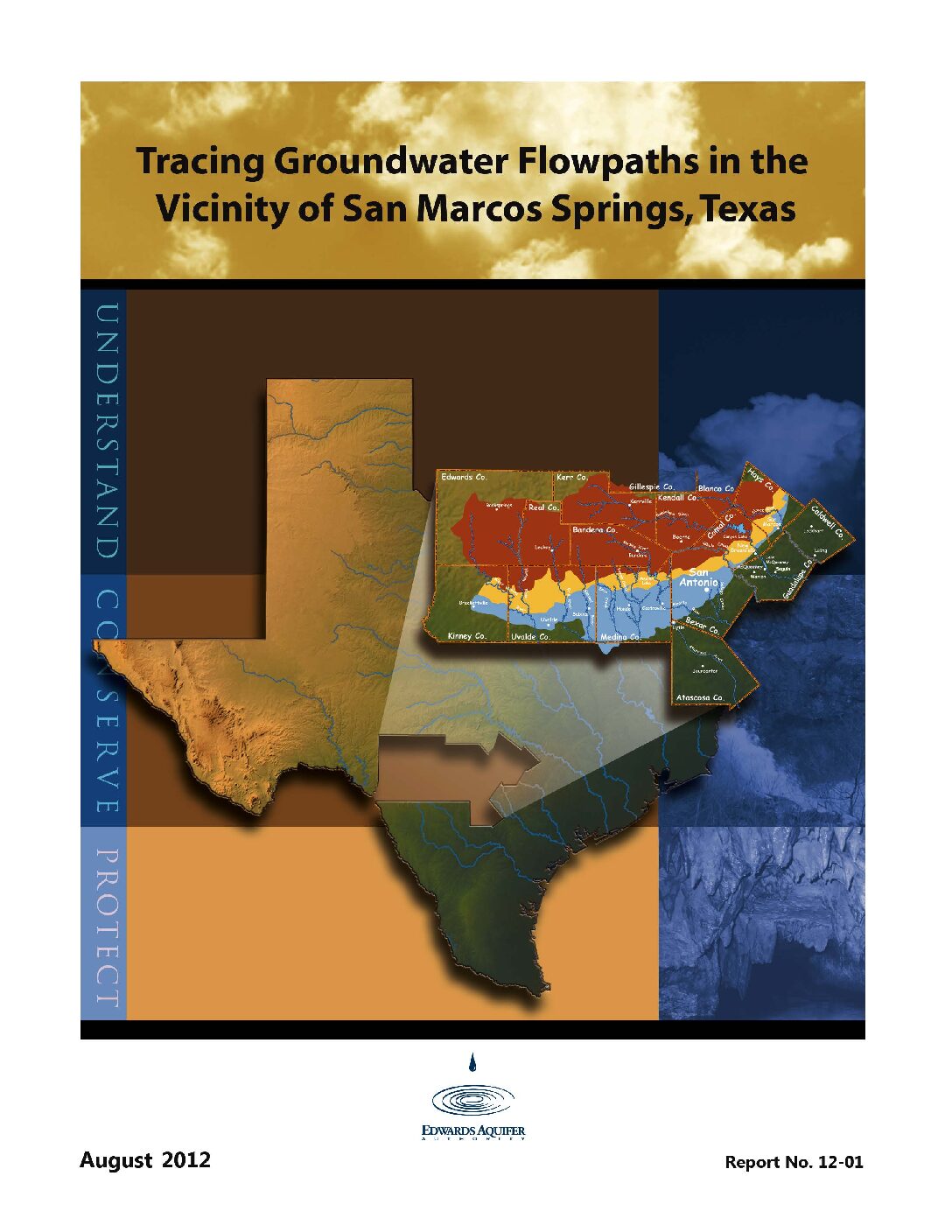
Description: Tracer studies of the San Marcos Springs springshed from 2002 -2010
Report Number: 1-Dec
Location: Edwards Aquifer, Balcones Fault Zone, San Antonio Segment, San Marcos Springs springshed, Hays County, Balcones Springs Segment, Travis County
Summary:This report presents the findings of investigations by the Edwards Aquifer Authority (EAA) along with other agencies regarding groundwater flowpaths in the San Marcos Springs springshed. The purpose of this study was to characterize the nature of groundwater flow to San Marcos Springs in the Edwards Aquifer recharge zone in Hays County in south-central Texas. Part of the investigation was focused on defining the groundwater boundary between San Marcos Springs in the southern segment of the Edwards Aquifer and Barton Springs in the Barton Springs segment of the Edwards Aquifer. The scope of this investigation consisted of 31 tracer tests (dye injections) completed between 2002 and 2010 at various locations in the vicinity of San Marcos Springs. Results of the tracer tests revealed discrete groundwater flowpaths and groundwater velocities up to several thousand feet per day connecting the recharge zone to San Marcos Springs and Barton Springs, which is consistent with the karstic nature of the Edwards Aquifer. The results indicated that San Marcos Springs and Barton Springs are important discharge points for the regional Edwards Aquifer flow system. Based on the fastest groundwater velocities, San Marcos Springs receives most of its recharge from the southwest along the San Marcos Springs Fault and smaller amounts from west and north of the springs. The boundary between San Marcos Springs and Barton Springs springsheds lies near the confluence of the Blanco River and Halifax Creek under drought conditions when Onion Creek is dry. The divide moves north along Onion Creek in the recharge zone during wetter conditions when Onion creek is flowing and recharging groundwater. Consequently, the Blanco River can recharge both spring complexes depending on hydrologic conditions.
 Conditions
Conditions

 CURRENT
CURRENT 
